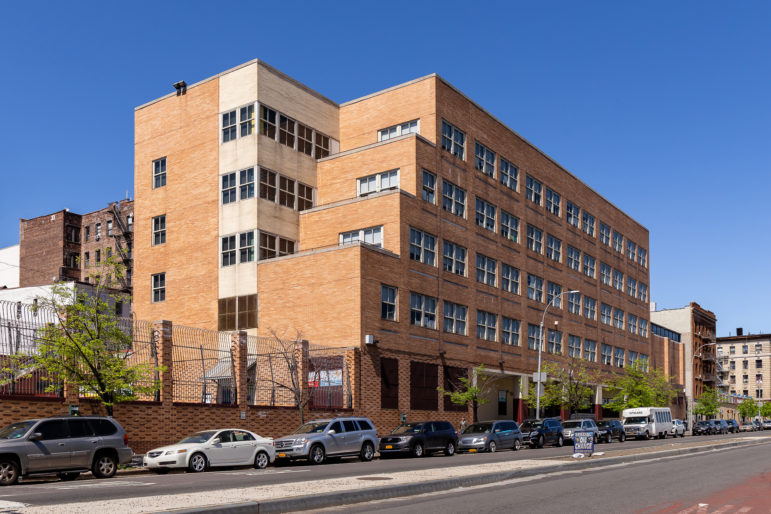
City Limits/Adi Talwar
Assembly District 78, which includes P.S. 54 on Webster Avenue (above), has the highest number of voters per polling place in the Bronx, while neighboring AD 80 has the lowest.
The 2018 midterm elections saw huge turnout across the country, the highest rate in a midterm election for more than 50 years. New York City was no different – despite having few competitive elections on the federal ballot, the city saw a 15 percent increase in turnout from 2014.
But New Yorkers faced a voting hurdle unlike voters in most other major cities: a relatively low number of polling places, scattered unevenly through the city, that forces voters to wait in long lines and makes voting a far more challenging task in the city than it has to be.
Voting problems afflict nearly every major election in New York and some of that trouble results from serious flaws in management of polling places in the city, done by the New York City Board of Elections (BOE).
The relatively small number of polling places creates a voting system at high risk for dysfunction whenever turnout peaks on Election Day. Additionally, the unevenness with which polling places are placed across the city creates significant inequality in access to voting in the largest city in the United States.
Dysfunctional voting in New York City
It would surprise few New Yorkers that the way elections are administered in the city could play a part in the longstanding trend of low turnout in the city. In 2018, thousands of voters stood in pouring rain for hours to vote, only to find that one or more of the voting machines at their polling place was broken. Numerous articles reported that people were sent away from their polling places, and told to return later when things were in working order. Reports compiled by ProPublica’s ElectionLand project showed issues with polling places stretched through the boroughs, hitting Brooklyn the hardest.
Brooklyn Voters Alliance, a nonprofit focused on organizing Brooklyn voters for election reform, held a meeting with voters after the midterms where many expressed their frustrations with the voting experience in 2018. “People were voicing what I would say is ‘breaking of the compact,'” says Alliance executive committee member Jan Combopiano, referring to the many ways that polling places did not function as smoothly as they were supposed to. “[Voters] were doing their part: They were showing up ready to vote,” Combopiano adds, but polling places were unprepared to manage the crowds of New Yorkers.
These issues were only exacerbated by state and local policy. New York, unlike many states in 2018, had no early voting, meaning the vast majority of interested voters attempted to vote on the same day (A mere 3.3 percent of voters participated by absentee ballot). The city also introduced a new two-page ballot in this election (Staten Island did not use this ballot), which had to be separated along a perforated edge before each page was scanned into the voting machine manually. This meant each person took more time at the vote scanning machine, with more opportunity for the machine to malfunction in processing a vote. When the pages jammed – which happened more frequently due to the humidity in the air from all the rain the city experienced and “overzealous” poll workers pushing them into the machine too quickly – lines grew.
The BOE, which oversees the setup and administration of polling places across all five boroughs, was roundly criticized for what was viewed as a terribly dysfunctional day of voting. Citing the fact that the 2018 election’s problems were nothing new, City Council Speaker Corey Johnson compared the unchanging voting conditions to “Groundhog Day” and called for the resignation of the BOE’s executive director. Mayor Bill de Blasio also called for reforms to the Board, and for the state to pass election-law changes that would increase voting.
One issue that wasn’t raised following New York’s 2018 Election Day problems was the physical location of polling places in the city. The BOE determines the location of those polling places but publicly explains very little about those determinations. In 2018, the city had 1,231 polling places spread across all five boroughs and 5,137,948 registered voters, meaning that there were on average 4,173 voters assigned to each polling place on Election Day.
That number is incredibly high relative to the rest of the country, including other major cities. When estimated in the 2004 midterm elections, the national average number of voters per polling place was around 800. The average number of registered voters for each polling place in Los Angeles County was under 1,300 voters, while the average in Chicago was about 725 voters. Not only do these two major cities have far fewer people assigned to each polling place, they both had early voting and ballot drop-off centers open well before the election to relieve pressure on their polling places on Election Day. Chicago’s Board of Elections determines the number of polling places in part based on a state mandate capping number of registered voters to be assigned to a polling place, a feature that New York State does not have in its election laws.
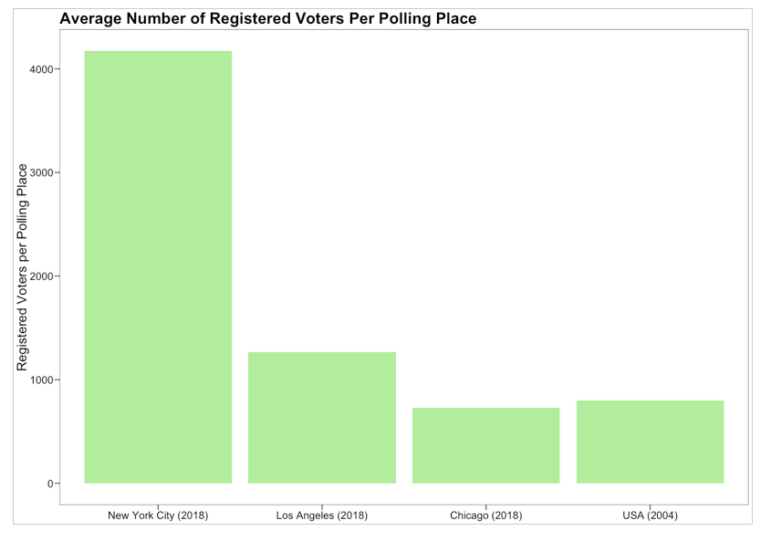
Huge numbers of voters expecting to use such a limited number of voting booths lead to long lines and greater frustrations around elections. However, the dangers of having such large number of voters allocated to each polling place goes beyond frustration. Greater lines add to the “cost of voting” for each voter, something that political scientists have studied for decades.
“Voting is a costly activity, and just one of many activities competing for a person’s limited time,” says Moshe Haspel, Adjunct Professor in the Department of Political Science at Emory University. “It takes time and effort to inform yourself about the candidates, get to the polls during the the limited hours they are open, and stand in line to vote.”
When the time and energy a voter must expend to cast their ballot are increased, voters become less likely to turn out to vote at all. So says decades of research into voter behavior, backed up by experiences even in recent elections. Haspel has shown in his own research that even minor issues with polling-place location can influence voter behavior. “A seemingly unimportant administrative detail such as where polling places are sited can have an impact on voting by making this activity more or less costly,” he says.
Some have made sinister use of the cost of voting. The United States has a dark history of manipulating polling places to suppress voter turnout, particularly of nonwhite voters. Similar behavior has continued in some parts of the county in the 21st century. Research by the Leadership Conference on Civil and Human Rights showed hundreds of poll closures across southern states, especially after oversight of election procedure diminished in 2013. “[W]hen polling places are closed, … it creates barriers to the ballot that are incredibly difficult for people to overcome,” says Leigh Chapman, director of the voting rights program at the Leadership Conference.
With three of the city’s boroughs included in Section 5 of the Voting Rights Act of 1965, requiring preclearance before any changes to election laws, New York City is not exempt from this history. The Bronx, Brooklyn, and Manhattan were all named in the Voting Rights Act particularly because of their history of Latino voter suppression.
To be sure, there is no evidence that the BOE’s placement of polling places is intended to depress turnout in the 21st century, and indeed the BOE does have supporters even among advocates for reform. Combopiano notes that as a whole, New York City’s elections are some of the most intricate in the country to oversee. “I’m amazed they get all this stuff done, because it is quite complicated,” she says. Some of the employees of the BOE are also passionate about the cause of voter turnout, she added. Within the organization, “there are people who care about people voting, they want to make sure … there’s enough help for voters,” she adds.
Regardless of the motivation behind the BOE’s decisions around polling-place location, the effects remains an issue, as national studies show that long lines at polling places can also have serious long-term effects on voting. One study analyzing existing survey data found that long lines discourage voters from attempting to vote, and often decrease their trust in the fairness of elections over time. Several studies measuring the effect of consolidating multiple polling places found that pushing more voters to use the same polling places consistently led to decreases in voter turnout. “Everyone can’t afford to take off of work and wait in line for hours,” says Chapman. “For a lot of people, particularly voters of color [and] elderly voters…, these kinds of burdens increase their unwillingness to vote.”
These issues could have been avoided had the BOE acted proactively, opening new polling places to accommodate increasing numbers of registered voters. From 1996 to 2018, total voter registration in New York City has increased by almost a third to 5.14 million voters. The BOE considers 4.6 million of them “active voters” but even that number has increased substantially in recent years, by 8 percent from 2014 to 2016, and by 3 percent from 2016 to 2018. Yet the only major change the BOE made before 2018 was to shift almost 200,000 voters to different polling places– a move that, research suggests, had the potential to greatly discourage turnout and warranted an intense public-awareness campaign, something the BOE did not do.
The BOE’s failures here would be more understandable if they were a result of inadequate funding, but that doesn’t seem to explain the whole situation. Funding budgeted for the BOE for 2018, at $143 million, was the highest it had been in five years, and an increase of more than $20 million over 2017. That budget is slightly less than the 2018 budget for the entire Los Angeles County Clerk’s office, which received $153 million for all its activity including election administration, and eclipses Chicago’s Board of Election Commissioners 2018 budget of $15 million.
Furthermore, before the 2018 election, de Blasio offered the BOE an additional $20 million as part of a contract to implement major reforms to their activities. Citing his fears that voters would be disenfranchised “because of the Board of Elections’ outdated operations”, de Blasio targeted the funding towards improving the BOE’s communications with registered voters and building a more robust base of poll workers. While these reforms wouldn’t have addressed the issue of limited polling places, they would have undoubtedly improved the voting process, and are in line with the best practice recommendations that have been put forward by notable voting rights organizations. But the BOE rejected de Blasio’s offer, citing their plans to follow its own slower reform schedule, leaving us where we are today.
This isn’t the only time that the BOE has refused city offers to go beyond the baseline amount of voter support. Combopiano points to a budgeting debate a few years ago where the City offered the BOE more money to provide translation services in more languages. “The BOE said that the state only requires seven languages, and refused to do more than that,” she says. In 2019, when the city paid independent translators to assist voters in reading the ballot in the February special election, the BOE filed a suit challenging their presence in the last days before the election, a choice that Combopiano was frustrated by. “It’s nuts that they were wasting taxpayer money and time literally the day before an election to try to stop something that was meant to help voters,” she says.
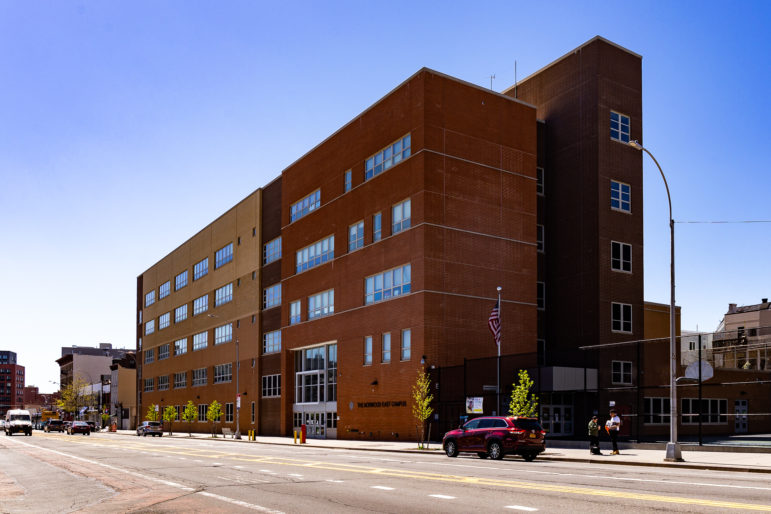
City Limits/Adi Talwar
Assembly District 80, which includes Bedford Park Elementary School on Webster Avenue, has the lowest number of voters per polling place in the Bronx.
Polling resources are uneven
Another reason to care about polling place access is that it can be unequal. In a democratic system, voting should be free and fair, and no person’s vote should be privileged over another’s. That mandate of equality should also extend to voting access – polling places should be well-distributed so that no group of people bear a higher burden when it comes to getting to a polling place or waiting in a long line to vote.
“Every eligible voter should be able to cast a ballot freely and fairly,” Chapman says. “When policymakers erect unnecessary barriers to the ballot, our democracy is less representative than it should be.”
There is no published information on the exact process by which the BOE determines the location of polling places in the city, though it is generally known that the Board must comply with federal accessibility requirements and ensure that locations can accommodate many electronic voting machines. These location choices involve complicated tradeoffs for the BOE. “Sometimes the BOE will continue to go to a place that’s ADA compliant that’s hard for some people to access, but when they do change the place, other people are like ‘wait a sec, the old polling place was just across the street, this one is five blocks away’,” Combopiano says. “And if you’re an older person or disabled, five blocks is a huge distance.”
The BOE did not respond to multiple requests for comment on this article. However, public data shows how unevenly polling places are distributed, resulting in dramatically different voting contexts.
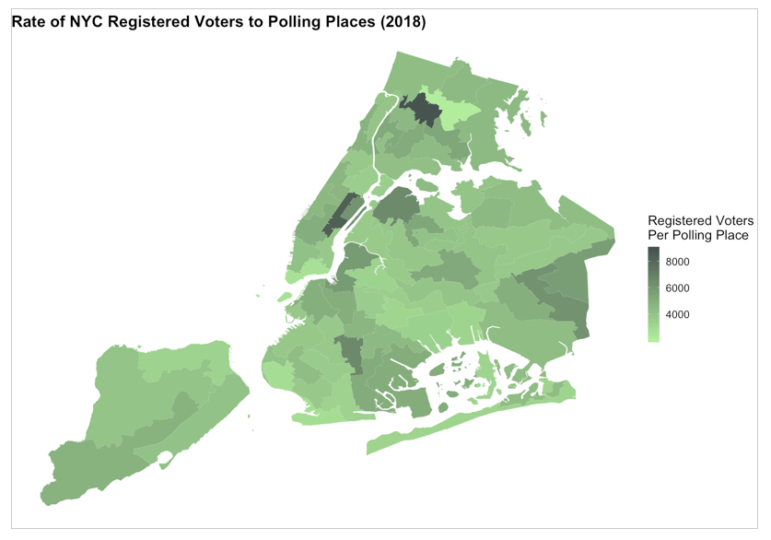
This map shows the number of registered voters per polling place for each of the 65 state assembly districts (ADs) in New York City, with lighter green indicating a smaller number of voters per polling place and darker green indicating a larger number. The map illustrates the vast differences in how many people are assigned to each polling place across the city, even in neighboring districts. The highest number of voters per polling place is in the Bronx (AD 78), directly next to the district with the lowest number of voters per polling place (AD 80).
Polling place allocations across the city appear scattershot, not done in a way that evens the burdens of voting among citizens. Other high-burden districts in Manhattan (AD 73), Queens (ADs 36 and 29), and Brooklyn (AD 42), are often surrounded by many districts with far lower ratios of registered voters to polling places.
New Yorkers’ uneven access to polling places could easily result in unfair voting conditions, where some people must wait in longer lines and use voting machines that are under greater strain. Any malfunctions or issues that slow down the voting process in these underserved areas of the city are magnified by the fact that their polling infrastructure is already stretched so thinly.
These burdens also affect voters at varying rates, depending on the amount of time and energy they are willing to spend at the polls on election day. Chapman notes that this is exactly what the Leadership Conference meant when they say that having less access to the polls suppressed voter turnout. Having fewer polling places, “make[s] voting more logistically challenging for some people than others, and usually it’s the very people for whom voting is already fairly challenging.”
There is evidence to suggest the inequitable distribution of polling places among New York voters has an effect on turnout.
In 2018, turnout in general followed broad demographic trends, with wealthier boroughs and neighborhoods experiencing higher turnout. Staten Island and Manhattan, the two boroughs with the highest median incomes, have higher turnout, while parts of the Bronx and Brooklyn with lower median incomes have lower turnout.
Interestingly, of the two neighboring districts in the Bronx that had starkly different rates of voters per polling place, the district with more polling places experienced higher turnout in 2018. Indeed, my analysis of the 2018 midterm election results showed that the turnout rate in each AD tracks the number of polling places per AD (constructed to be approximately the same population).
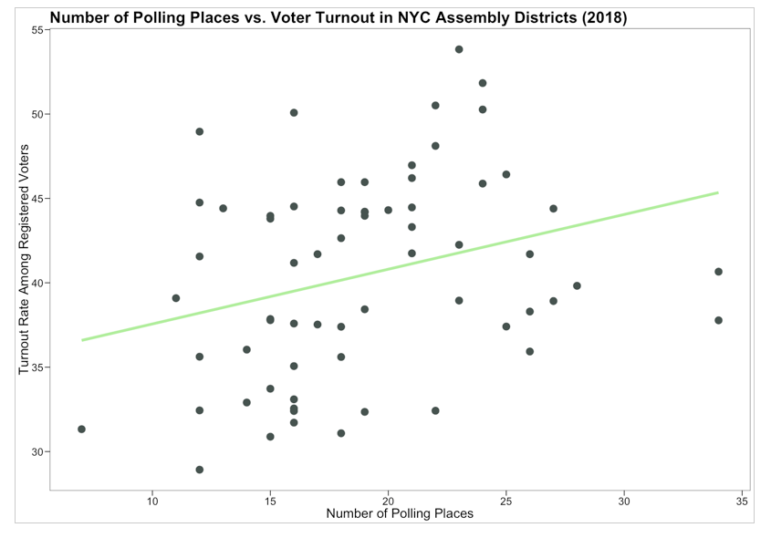
The best way to determine the specific impact of having fewer polling places is through multiple regression analysis, controlling for important factors that affect turnout. In my model, I included controls for the competitiveness of the AD election and for the number of poll workers. Competitiveness, measured by how close the final vote result was for the AD race, was controlled for because this is a well-documented factor that has consistently been shown to be a strong influence on voter turnout.
I also controlled for the number of poll-workers, measured by calculating the average number of Election Districts per polling place, since the BOE’s policy is to staff polling places based on the number of Election Districts that vote there. By controlling for number of poll workers, I was better able to separate the effect of having well-staffed polling places from the effect of having fewer polling places in one AD.
When controlling for these factors, the number of polling places per AD significantly affects voter turnout (p>> 0.05, R squared = 0.1979), with fewer polling places causing a decrease in voter turnout. With districts having anywhere between seven and 34 polling places, data show that thousands of voters could have been discouraged from voting in 2018 based on the fact that they live in a part of the city that the BOE has decided to place fewer polling places in.
This regression analysis indicates a connection between the number of polling places and turnout, although the impact of race, income, and educational attainment on voter turnout behavior is absent from this analysis (none of these trends are measured at the AD level). These trends likely played a role in predicting average turnout in ADs across New York City much like they do in the rest of the country, and it would be valuable to understand how significant that impact is on the city’s elections. However, given the fact that polling place placement doesn’t seem to track with any of them consistently, this analysis remains a testament to the impact that the BOE procedure around polling places has had on voter behavior.
The current state of election administration in New York City paints a harrowing picture of the voting process. For the millions of New Yorkers who choose to vote in any given election, the process of casting their ballot may take hours or mere minutes, influenced in part by the decisions made by the BOE. These little-known choices about where to place polling places and how many people to assign to each have had a measurable impact on whether or not voters choose to wait despite the assortment of problems that polling places experience on election day, and their effects are irreversible. “Once an election is over, there is no remedy for the loss of votes that were never cast,” Chapman says. “There are no do-overs.”









2 thoughts on “In New York, Where You Live Can Determine How Hard it is to Vote”
I voted at PS 33, on W26th St, 9th Av, district 3, Manhattan. It was pouring, long lines, parents holding small kids, I had just come from MD who told me not to stand long after foot injection. I repeatedly asked security guards if people could wait inside, out of rain, school was closed, lots of space, told no. Some people left, in effect were disenfranchised. I called Dept of Elections and Corey Johnson (his district) to report this while polls still open. I was told that Selis Manor on W23 let people inside and I have waited in auditoriums at other Chelsea schools during presidential elections with overflowing lines. Terrible experiences st PS 33
The BOE isn’t really corrupt, per se, but it is incredibly, outrageously dysfunctional and incompetent. When it comes to the BOE in New York, incompetence should always be the first explanation that springs to mind. No one gets anything done, the different appointees from the different parties refuse to work with each other, it’s a mess. Even more than the average bureaucracy, it’s an environment that prevents good ideas, good planning, and good execution.